Quick Answer:
- Distressed leaves turn brown, indicating that water isn’t reaching the foliage.
- Other reasons why fiddle leaf fig leaves are turning brown include harsh weather, too much light, pests, and diseases.
Fiddle leaf figs are large glossy plants native to tropical Africa. They grow beneath rainforest trees in warmth and humidity, but these conditions are hard to replicate, so sometimes their foliage suffers. Here’s all about fiddle leaf fig leaves and why they are turning brown.
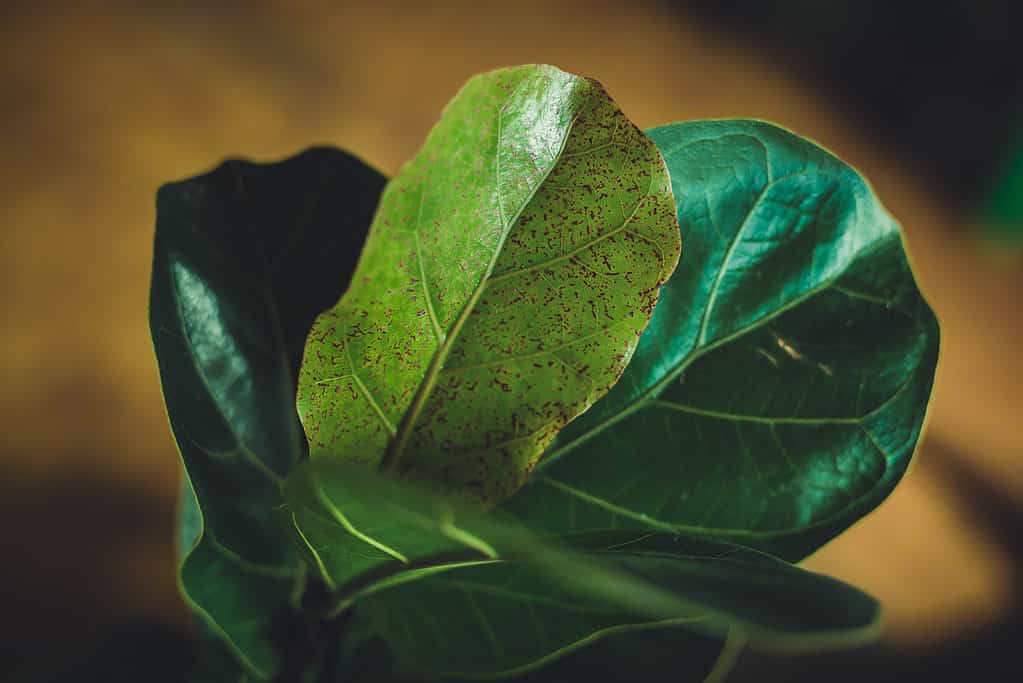
Distressed leaves turn brown, and it’s usually an indication that water isn’t reaching the foliage.
©Przemyslaw Zielinski/Shutterstock.com
Why Are They Turning Brown: Fiddle Leaf Fig Leaves
Distressed leaves turn brown, indicating that water isn’t reaching the foliage. Why water hasn’t reached the foliage is caused by a number of reasons, but if it’s just the tips that are brown, that’s usually a watering problem.
Other reasons why fiddle leaf fig leaves are turning brown include harsh weather, too much light, pests, and diseases.
Once the leaves turn brown, there’s no going back, so let’s take a look at how you can prevent it from happening in the first place.
Brown Fiddle Leaf Fig Leaves Due to Underwatering
Browning leaf tips are a sign that lost water hasn’t been replaced. When a fiddle leaf fig has enough water, it’s sucked up by the roots into the stem and finally reaches the leaf tip. However, when there’s not enough water, the plant uses it to first replenish its cells. This means the leaf tips lose out.
To prevent underwatering from turning your fiddler’s leaves brown, learn how to implement a good watering regime. More on that below.
Overwatering Causes Brown Leaves
A plant’s roots need both water and oxygen to survive. When the soil is consistently soggy, oxygen can’t reach the roots. This damages the roots and prevents efficient water takeup. When water can’t reach the leaves, they become dehydrated and turn brown.
If the soil is always soggy around your fiddler, it’s likely causing brown leaves. Let it dry out, and with some luck, the roots will recover.
One thing to check for is sufficient drainage in the liner pot. If there are too few drainage holes, water can’t escape, and the soil waterlogs. This damages the fig’s roots, and brown leaves begin to appear.
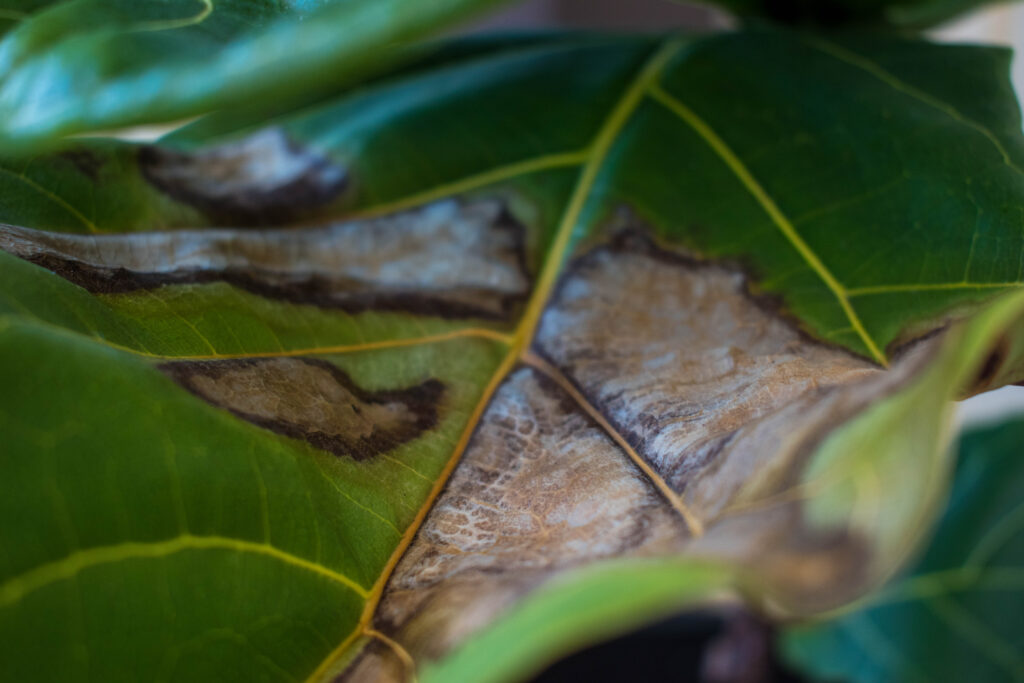
If the soil is always soggy around your fiddler, it’s likely causing brown leaves.
©Kara Knight/Shutterstock.com
Too Much Fertilizer
Fiddle leaf fig leaves can turn brown if they’re exposed to too much fertilizer. It’s a case of killing with kindness.
This is usually only a reason for brown leaves on houseplants because outside, excess fertilizer is leeched away by ground soil. In a container, too many salts can build up in the soil. They draw away moisture and cause tip burn. As a result, the leaves turn brown.
You might notice a white crust on the pot or soil; if so, sit your fiddler in a sink or bucket of water and let the water flush away excess fertilizer. Change the water several times to make sure fertilizer is flushed away.
Brown Fiddle Leaf Fig Leaves: Pests and Disease
If under or over-watering isn’t causing brown leaves, it might be pests or disease. Here are the main pests and diseases of fiddle leaf figs.
Aphids
They are more likely to infest an outside fiddle leaf fig, but if your windows are frequently open, they could also make it indoors. These miniature vampires suck life-giving sap from plants. They usually prefer new growth, and they breed at light speed once they’re established. Poor, stunted growth is the most obvious symptom of aphid damage. Brown leaves occur when they’ve got a strong grip on a fiddler.
Songbirds and ladybugs are natural predators, but you can remove aphids with dish soap and water or citrus peel soaked in water.
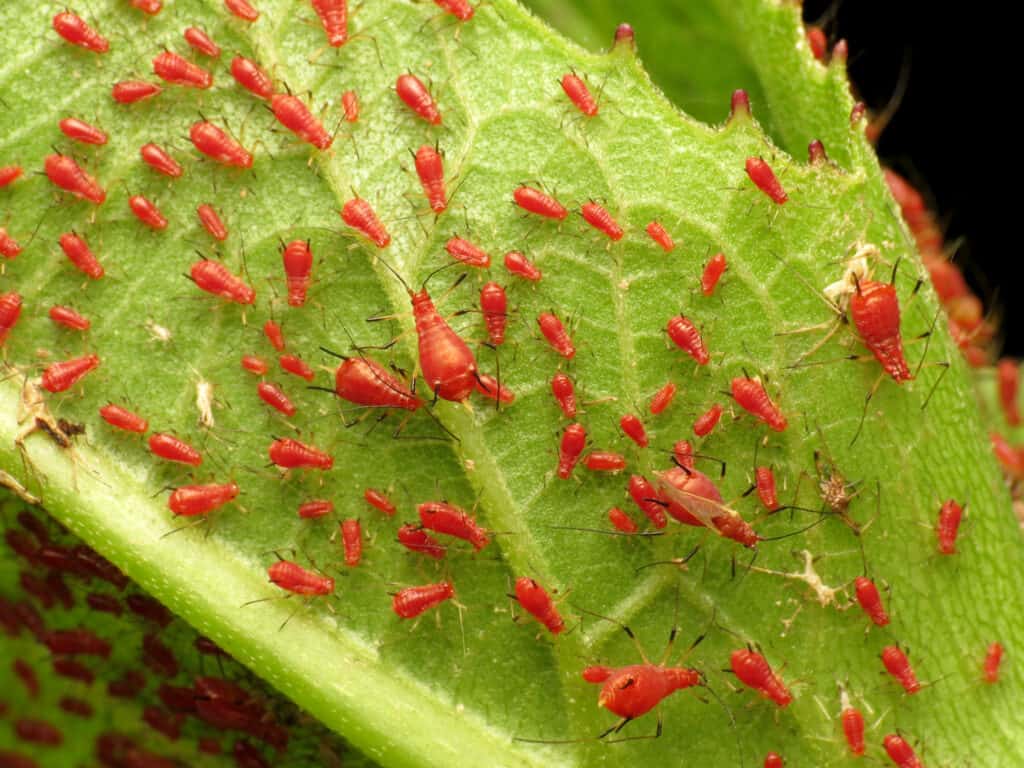
Aphids are more likely to infest an outside fiddle leaf fig, but if your windows are frequently open, they could make it indoors, too.
©treegrow_Katja Schulz/CCBY2.0 – License
Spider Mites
Spider mites spin small white webs in a fiddle leaf fig’s crevices, but you may also spot small brown dots on the leaves. These leaf dots are spider mites. Take a photo on your cell phone and zoom in, or use a magnifying glass to check. If it’s spider mites, you can dislodge them with water jets and rub neem oil over the leaves to kill eggs.
Pet Urine
Consider whether Rover is cocking his leg on your fiddler! Urine turns green and leaves brown very quickly.
Mildew
Mildew is caused by bacterial spores floating around the environment. If they land on your fiddle leaf fig, they can cause mildew and brown patches. Fiddlers in poor health are more likely to develop mildew, so keeping them in good health can prevent brown leaves.
Brown Leaves and Root Damage
We already know that poor water uptake turns leaves brown. Sometimes, poor water uptake is caused by damaged roots. Root rot from overwatering is the most common cause, but there are other reasons.
The best way to check is by taking your fiddler from its pot and looking at its roots to see whether pests, rot, or other damage is causing a problem. It might be someone is dumping their coffee dregs in the pot or trying to helpfully water it with their juice box.
Outdoor root damage could be caused by excess heat. Because they are rainforest natives, the soil around their roots should be moist and cool. Use stone or broken crock pots to create a cool root surface. It’ll help trap moisture as well.
Too Much Light Causes Brown Leaves
Light scorch is a common reason for brown leaf patches. This usually manifests as rough brown areas on leaf surfaces rather than brown tips. Once it’s scorched, there’s no going back, so keep a fiddle leaf fig out of direct sunlight. Sunlight through a windowpane is magnified and capable of burning large brown patches on glossy fiddlers.
Harsh Wind and Extreme Weather Temperatures
Outdoor fiddlers are at risk of harsh winds and excess heat or cold, all of which will turn leaves brown. A sheltered outdoor position is essential for healthy-looking fiddle leaf figs.
Indoor fiddlers are tested by drafts, central heating, and air conditioning. Unsuitable temperatures cause brown leaves, usually patches, so ensure your handsome fiddler is away from radiators and air conditioning units plus frequently opened doors and windows.
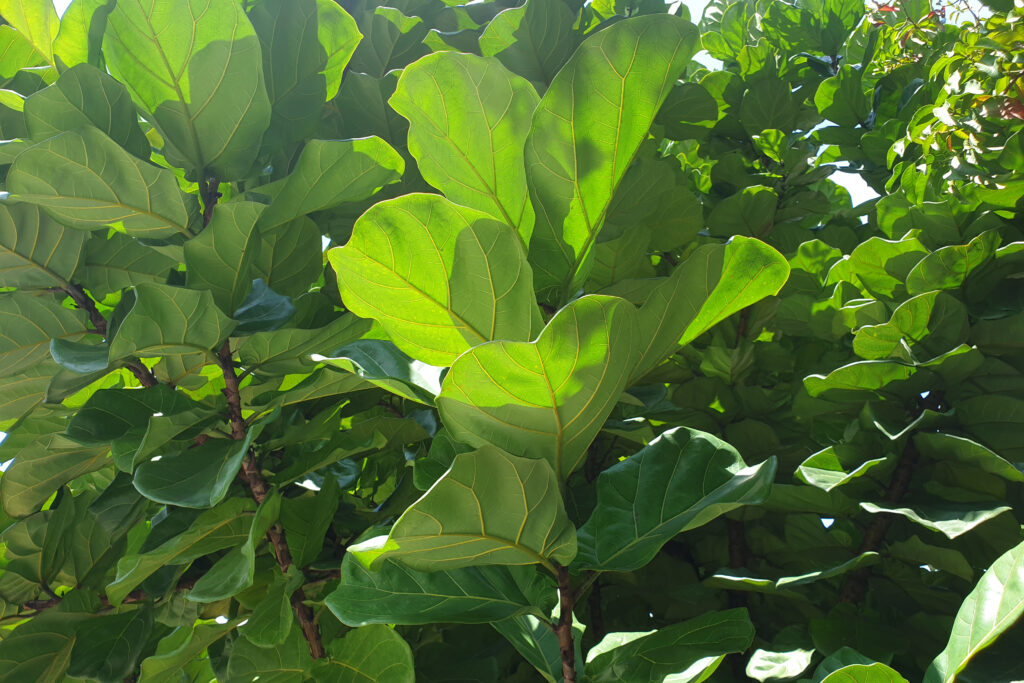
A sheltered
outdoor position is essential for healthy-looking fiddle leaf figs
.
©TY Lim/Shutterstock.com
Moving a Fiddle Leaf Fig
Fiddle leaf figs are known for grumpiness! They don’t like being moved and show their displeasure through brown leaves and/or dropping their foliage. It will recover if the new position is suitable.
4 Other Tips for Healthy Fiddle Leaf Figs
A Good Watering Regime
Fiddle leaf figs need a good stable watering regime to flourish. Brown leaves are one of the signs it’s unhappy, so here’s how to water it well.
Although some people recommend watering a fiddle leaf fig once a week, this isn’t always the best way. The best method is to touch and test. This means testing the soil to see if your fiddler actually needs a drink.
Push your finger into the soil. If it’s dry down to an inch, it’s time to water it, but if it’s still damp, leave it and check again in a few days.
Put small fiddlers in a sink of water for a few hours, then let them drain on the draining board. A deep, thorough soak is much better than a dribble each day.
Give large fiddlers a cup or two of water until the soil is saturated and leave it to dry out before watering again.
The touch and test method is the only way to understand what your fiddle leaf figs need.
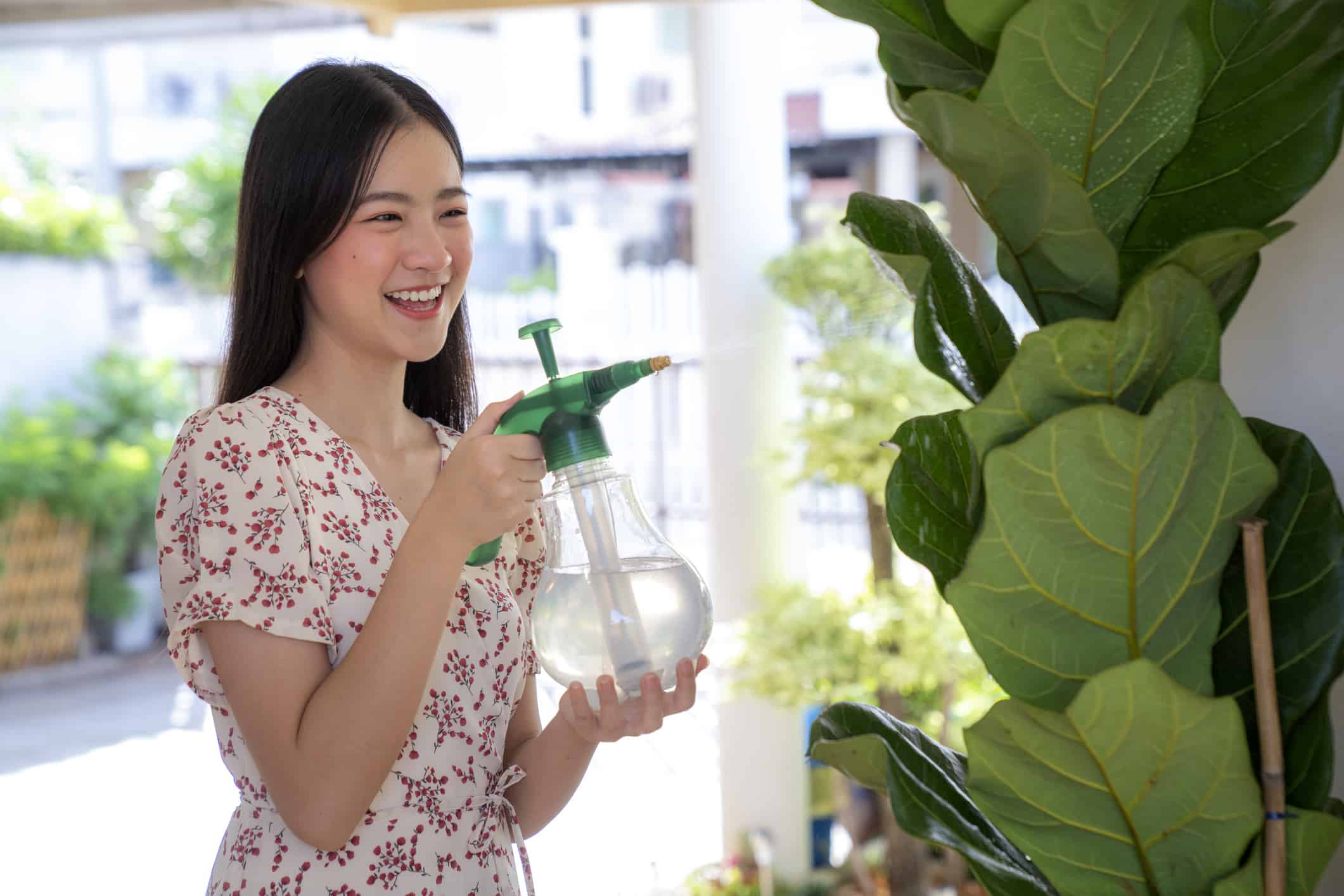
Fiddle leaf figs need a good, stable watering regime to flourish.
©iStock.com/NeoPhoto
Extra Fertilizer
A dull, brown-leaved fiddle leaf fig needs a good watering regime, but it may need fertilizer too. Pot-bound fiddlers use up their nutrients quickly and when they are gone, they rely on you to feed them.
Buy a houseplant fertilizer and follow the instructions so you don’t use too much and turn the leaves brown.
Pale or Dull Leaves
Pale or dull leaves usually indicate under or over-watering or too much light. Adjust its position or watering regime and new growth should return to its rightful glossy, healthy self.
Up the Humidity
Rainforest plants like fiddle leaf figs need humidity to thrive, but in our air-conditioned, centrally heated houses the air is dry and this might cause brown leaves. You can improve humidity by misting your fiddler a few times each week. Washed-out kitchen or bathroom cleaner spray bottles are just fine for the job.
Brown Fiddle Leaf Fig Leaves: Recap
Let’s recap on fiddle leaf fig leaves: why are they turning brown?
Brown leaves are not attractive and they really ruin the aesthetics of a glorious fiddle leaf fig.
Browning isn’t reversible, but the causes are. Investigate whether you’re over or underwatering it, or whether you’ve given it too much fertilizer, look out for pests or disease, block drafts or radiator heat, and assess how much light is falling on your fiddler’s foliage. Once you’ve identified the culprit and changed things up your fiddle leaf fig will produce new leaves without a hint of brown.
The photo featured at the top of this post is © Fajar Tri Amboro/Shutterstock.com
Thank you for reading! Have some feedback for us? Contact the AZ Animals editorial team.






